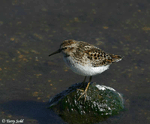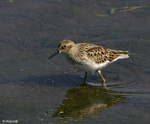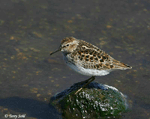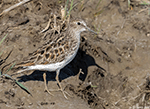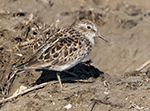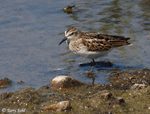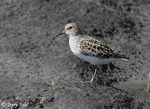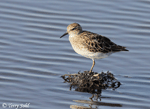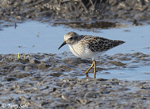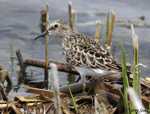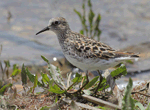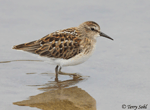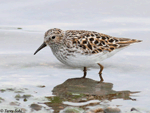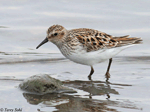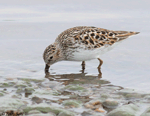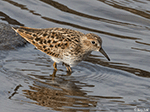| Length: 6 inches | Wingspan: 11 inches | Seasonality: Migrant |
| ID Keys: Tiny size, pale yellow legs, slightly decurved bill | ||
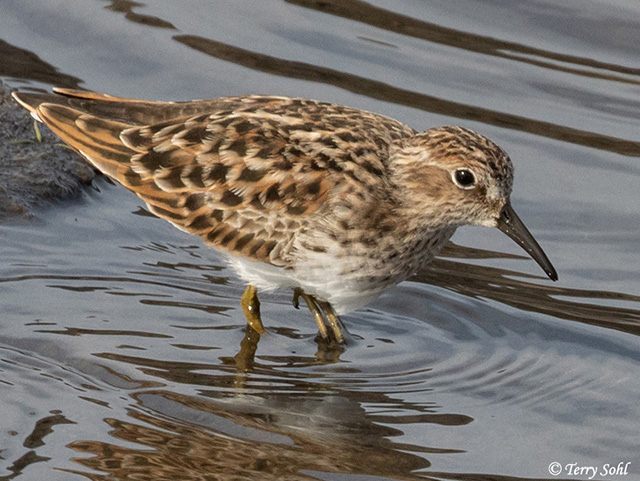 Least
Sandpipers are the the smallest of the "peeps", the small sandpipers
that migrate through the state. Indeed, they are generally considered the
smallest shorebird in the world. Despite their tiny size, they are long-distance
migration champs, with many birds making a non-stop flight from southeastern
Canada or then northeastern US to wintering grounds in northeastern South
America. The most common of the small sandpipers to
migrate through South Dakota, a primary identification key are the pale yellow
legs, as the other peeps have dark legs.
Least
Sandpipers are the the smallest of the "peeps", the small sandpipers
that migrate through the state. Indeed, they are generally considered the
smallest shorebird in the world. Despite their tiny size, they are long-distance
migration champs, with many birds making a non-stop flight from southeastern
Canada or then northeastern US to wintering grounds in northeastern South
America. The most common of the small sandpipers to
migrate through South Dakota, a primary identification key are the pale yellow
legs, as the other peeps have dark legs.
Habitat:
During migration, Least Sandpipers are found on mudflats, shallow marshes, flooded fields, and shorelines. On their breeding grounds in Alaska and Canada, they are found on boggy tundra and wet meadows.
Diet:
Variable but primarily consists of insects and other small invertebrates such as snails, spiders, or small worms. They sometimes supplement their diet with the seeds of wetland grasses.
Behavior:
Primarily forages on mudflats and shorelines, picking up food items from the ground, occasionally by probing in the mud with its bill.
Breeding:
Non-breeder in South Dakota. On their breeding grounds in northern Canada and Alaska, Least Sandpipers nest on the ground, building a shallow scrap on a tuft of higher or drier grass in wetland areas. The male builds multiple scrapes, with the female inspecting them and making the final choice of nesting location. She lays 3 or 4 eggs, and both parents help to incubate them. The eggs hatch after about 3 weeks. The young leave the nest within a day or two of hatching and must feed themselves, but the male typically stays nearby and protects them.
Song:
High thin keee-eeet is the most common vocalization heard as they migrate through the United States. Breeding males in Alaska and Canada have a surprisingly complex series of trilled and warbling notes.
- 1Click here to hear alarm calls of a Least Sandpiper near a nest, recorded on the North Slope of Alaska.
- 2Click here to hear the song of a male Least Sandpiper, recorded near Nome, Alaska.
- 3Click here to hear the simple calls of a Least Sandpiper, recorded in New Brunswick.
Migration:
Many winter in the Southern United States and near the US coastlines, while others migrate as far away as northern South America.
Interactive eBird Map:
Click here to access an interactive eBird map of Least Sandpiper sightings
Similar Species:
Least Sandpipers can easily be confused with the other "peeps"...the small sandpipers...that migrate through the state. Compared to the other similarly sized sandpipers, the yellow legs are unique. Species most likely to be confused with the Least Sandpiper include the following:
- Semipalmated Sandpiper - The species most often confused with Least Sandpiper in South Dakota, the bill of a Semipalmated Sandpiper is generally thicker and shorter than the Least Sandpiper, with its thinner and slightly drooping longer bill. The legs on a Semipalmated Sandpiper are also dark, compared to the yellow legs of a Least Sandpiper.
- Western Sandpiper - Western Sandpipers are uncommon migrants in the state, as they're typically found closer to the coast. However, they can easily be confused with a Least Sandpiper. The dark legs and slightly thicker bill distinguishes them from the Least Sandpiper.
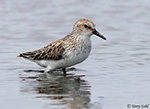 |
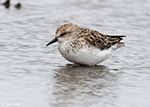 |
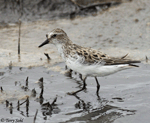 |
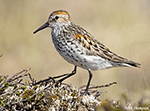 |
| Semipalmated Sandpiper | Semipalmated Sandpiper | Semipalmated Sandpiper | Western Sandpiper |
Conservation Status:
Populations are undoubtedly lower than they were historically, prior to European settlement of the continent. Populations have also been in decline in the last several decades. However, they are still relatively common, have strong overall populations, and are found across a very broad geographic area. The IUCN considers the Least Sandpiper to be a species of "least concern".
Further Information:
- USGS Patuxent Bird Identification InfoCenter, Least Sandpiper
- WhatBird - Least Sandpiper
- Audubon Guide - Least Sandpiper
Photo Information:
May 3rd, 2020 - Lincoln County, South Dakota - Terry Sohl
Additional Photos:
Click on the image chips or text links below for additional, higher-resolution Least Sandpiper photos.
Audio File Credits:
- 1Andrew Spencer, XC203604. Accessible at www.xeno-canto.org/203604.
- 2Peter Boesman, XC322794. Accessible at www.xeno-canto.org/322794.
- 3Martin St-Michel, XC145676. Accessible at www.xeno-canto.org/145676
| Click on the map below for a higher-resolution view |
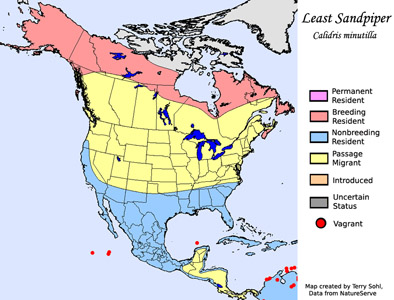 |
| South Dakota Status: Common migrant throughout the state. |
Additional Least Sandpiper Photos
Click for a higher-resolution version of these photos
